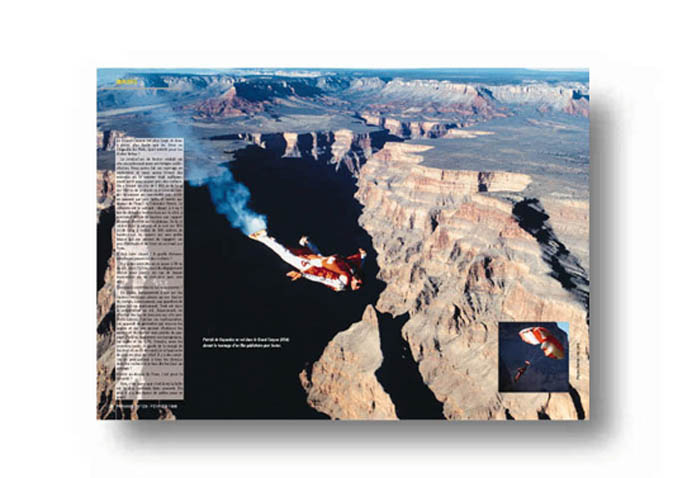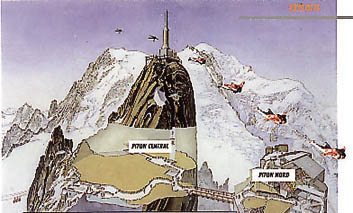Article of the month:
WING FLIGHT
Wing Flight It is the name chosen by Sector to illustrate Patrick de
Gayardon's exploits with his "birdman" wings. Sector has now
widely broadcast, on TV and other media around the world, the images of
his re-entry in a flying plane, of his hedgehopping flight over mountains
and of his jumping into an abyss. Is "our Deug" becoming part
of the new legend of the birdmen of the 21st century.
Text by Bruno
Passe- Photos by Sector No Limits

A few months ago, Patrick de Gayardon explained
us in details how he had managed to get back into a flying plane (see ParaMag
n° 124) but there was no image since his sponsor Sector kept them.
They can be seen now and we present them in this month issue, together
with a new interview of the birdman of the 21st century. "It is not
a stunt" Patrick de Gayardon said, talking about his re-entry in a
Porter over Chambéry (France) although he was already planning hedgehopping
jumps over the mountains: at the end of October, he passed in freefall
only a dozen metres from a terrace on the Aiguille du Midi (French Alps)
where Italian journalists where gathered (one headline was: "Superman
beaten!"). A month later, he did it again over the Grand Canyon, 50
metres away from Sector cameramen and photographers. A few metres from
the ground... It was a stunt alright and this is maybe what makes Patrick
de Gayardon a bit like the first birdmen, most of them had to pull low
to make their audience happy since their flying performances were not very
spectacular. Except of course for Léo Valentin who had obtained
with his big rigid wings performances similar to Patrick de GayardonÕs
with his supple wings. Unfortunately, the rigidity of his wings was fatal
since it prevented him from controlling a downwards spiral to the ground
caused by the malfunction of one of the wings just after leaving the plane.
Jumping with additional wingspan is not a new idea, René Roy had
told us the detailed history of these first birdmen (see ParaMag numbers
66 to 72). Their names were (for example) Clem Sohn, Léo Valentin,
Salvator Canarrozzo or more recently Gil Delamare. However, even with the
evolution of the freefall technique and of parachutes, one wonders how
Patrick de Gayardon could develop so successfully and so safely this new
skydiving way. We try to answer that with the following interview.

Could you imagine this exploits when you started
jumping with your wings, a few years ago?
II always liked tracking and I would explain to people that, for tracking,
one has to put his body in a wing shape in order to try to create a lift.
One day, an idea hit me: why not design a ram air wing, with an extrados
and an intrados, that would fit the body? And it worked! Then in Courchevel,
while looking at old pictures showing Air Alpes Porters diving in the mountains,
I told myself I could do the same with wings: long trackings over the relief.
Following the plane and climbing back in, came later and all the rest followed
step by step.
The Grand Canyon is wider and thus would be considered
easier than the Drus or the Aiguille du Midi. What was your motivation
for going there ?
Sector wanted an exceptional spot for its ads. We went on location
in September and found places where the canyon was narrow enough to pass
close to the rocks. There was a place 1800 m long and 700 m deep where
I could hedgehop the canyon and then leave by a break and pull over water
(the Colorado River). The plan was as follows : I started on the side of
the canyon at an horizontal distance of 4 or 5 km and 300 m above the entry
point on the plateau. From here, I entered the canyon and flew for a 900
m distance less than 200 m above ground level. The exit was over a small
cliff that gave me some extra altitude before pulling over the river.
 It must be hot! How far away are you from the
rocks?
Sometimes I was only 50 m from the ground but there was always room
on the side where I could go in order to open my parachute in case of a
wing problem or of a false manoeuvre.
How did you steer?
When in freefall, I only flew visually thanks to vertical marks on
the ground (rocks, cameramen...), looking at an instrument was out of question.
Everything is based on the preparation. Before a flight, a lot of measurements
are done on site with an helicopter. I used a surveyor device that measures
angles in order to get an estimate of slopes and help me choose my path.
I also used a barograph, an airspeed indicator and a GPS. For the first
jumps, I stayed rather high and, jump after jump, I got closer to the ground.
There were many cameras on the rocks and I saluted them as I went past!
Did you open your chute over water for safety
reasons?
No, it was because it is often where the break is deeper. Moreover,
There were sandbanks for landing.
Let's go back to the jump over the Aiguille du
Midi in October. It is hard to believe that you went in freefall just a
dozen metres from the journalists!
I have the digital camera footage though! One can clearly see that
I was one storey over the roof and that there was room for 3 storeys on
the side, it adds up to 3 to 4 storeys from the ground... It was a press
conference but the only photographer present couldn't take a picture!
What were the sensations?
People look big! A little before that, you feel it is getting more
narrow, you become more aware of the environment, rocks and altitude! There
is no room for mistake.
It must be hot! How far away are you from the
rocks?
Sometimes I was only 50 m from the ground but there was always room
on the side where I could go in order to open my parachute in case of a
wing problem or of a false manoeuvre.
How did you steer?
When in freefall, I only flew visually thanks to vertical marks on
the ground (rocks, cameramen...), looking at an instrument was out of question.
Everything is based on the preparation. Before a flight, a lot of measurements
are done on site with an helicopter. I used a surveyor device that measures
angles in order to get an estimate of slopes and help me choose my path.
I also used a barograph, an airspeed indicator and a GPS. For the first
jumps, I stayed rather high and, jump after jump, I got closer to the ground.
There were many cameras on the rocks and I saluted them as I went past!
Did you open your chute over water for safety
reasons?
No, it was because it is often where the break is deeper. Moreover,
There were sandbanks for landing.
Let's go back to the jump over the Aiguille du
Midi in October. It is hard to believe that you went in freefall just a
dozen metres from the journalists!
I have the digital camera footage though! One can clearly see that
I was one storey over the roof and that there was room for 3 storeys on
the side, it adds up to 3 to 4 storeys from the ground... It was a press
conference but the only photographer present couldn't take a picture!
What were the sensations?
People look big! A little before that, you feel it is getting more
narrow, you become more aware of the environment, rocks and altitude! There
is no room for mistake.

Trajectory of the birdman, after passing the Aiguille
du Midi, the flight ends safely in the Chamonix valley.
It is a big gamble then?
There was still some space left on the side and I could go to the left
to get some more altitude but you don't want to be stuck on a rock mass
without speed or room reserve. I was 30 or 40 kph over the normal speed
so that I could easily slow my fallrate down to get more altitude.
Opening the chute is then out of question...
For 3 or 4 seconds, you can only fly and steer, if your speed makes
it possible. Or you can get away on the side, but that's all. For the ones
who would like to try, it is only possible using the right suit with wings
liberators and a throwout. You can't play so close to the ground if you
can't pull instantaneously (without delay on opening!) and catch the commands
immediately.
Do you feel close to the first generation of
"birdmen"?
Yes, I think of them and tell myself "don't do what they did!".
Many of them used rigid parts when from my first jumps on my instructors
would forbid them because they said they were dangerous. I kept this in
mind. Mot of their wings were monosurface but a canopy must have both an
intrados and an extrados in order to fly correctly. I used this concept
for my suit. The only one who thought of bisurface wings was Léo
Valentin but they were rigid and it was unfortunately fatal for him.
What do the wings bring to BASE jump?
It becomes a bit like hand-gliding, the increase in finesse gives access
to new spots. In Italy, I could make a 32 second delay. The wings offered
me 1100 m of altitude. There is a kind of talus in the middle of the cliff
to avoid and if you do you get 450 m more at once. However, a lot of planning
with instruments was needed and I slowly increased the delay from 12 s,
then 28 s, then 30 s and finally 32 s. I did the last jumps with a stiletto
135, no more need for a BASE jump rig!
What is the next step ?
I have already made some BASE jumps starts with a snowboard (see ParaMag
n° 123), but it was still more a jump than a take-off because more
speed is necessary. To take-off, one must reach a 160 kph speed on the
snow. At the moment, we are working together with a motorbike suit manufacturer
to design a covering allowing me to stand the friction. The goal is to
take off from a snow slope on the belly and with the wings.
Patrick de Gayardon in short...
500 jumps with wings including: - 7 BASE jumps, - 75 jumps in several
places of the Grand Canyon (50 of them very close to the rocks). Vector
BASE jump parachute with a static between the main canopy and the reserve.
They are both big canopies from Performance Designs: 252 sq. feet for the
main and 200 sq. feet for the reserve. The last suits were made with the
collaboration of ToutAzimut and Katerina Ollikainen. Freefall pictures
in this paper are credited to Sector - No Limits and were taken by Charles
Boons (who made a total of about 100 jumps with wings) or Adrian Nicholas
(about 40 jumps with wings). Some pictures were taken under canopy by Gus
Wing, aimed by the "birdman"..., others by Philippe Fragnol from
the ground or the plane.




